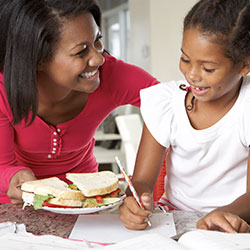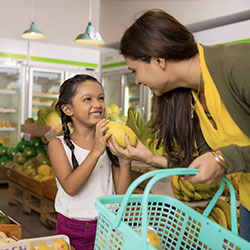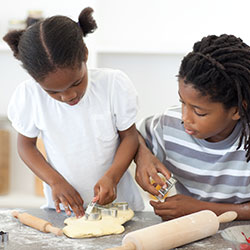"Grow Up Great" is a registered mark of The PNC Financial Services Group, Inc.
Mealtime Tips
When and how we eat create great opportunities for your child to learn.

Plan Meals Together
Ask your child what she would like to eat. Make a list of the meals you will have that week. Discuss the ingredients you need to buy to make the meals she requested. Did she choose something from each food group? Do they include healthy choices like fruits and vegetables? This is a great time to talk about which foods are good to eat every day, and which foods should only be eaten occasionally.
Planning meals with your child helps her:
- Understand how to make a healthy meal
- Be more likely to eat meals because she helped plan them

Make a Grocery List
Ask your child to help you create a grocery list. Plan out the meals you will eat for the week and write down the ingredients. As you write the items down, talk about what you are doing. “We are going to have spaghetti this week so I need to write down spaghetti noodles, sauce, and cheese. Let’s have broccoli with our spaghetti.” Give him paper and a pencil to help you “write.”
When your child helps make a list, he is learning that:
- Writing is used for a specific purpose
- Scribbles and pictures represent words

Follow a Recipe
Follow a recipe and cook with your child. Show her how to follow a recipe. Let her help you wash fruits and vegetables. Ask her to measure out ingredients and help mix them together. Explain why you need to follow a recipe. Ask her what she thinks would happen if you did not follow the recipe?
When you include your child in cooking, she is:
- Building her self-esteem as she completes a task
- Learning about math, science, and reading by following a recipe and measuring ingredients

Visit the Grocery Store
Visit the grocery store with your child. Talk about the items on your list and where you will find them. Show him where the healthy foods are (produce section, for example) and talk about what foods should not be eaten all of the time (candy, cookies). Let him cross the items off of the list as you get them. Describe the items as you place them in the cart. “A carrot is a vegetable and it is orange.”
Describing items and asking your child to describe what he sees helps him:
- Learn new words
- Learn how to follow directions

Share Family News
At the dinner table, ask everyone to share “news” about their day. Listen to what your child has to say and share something that happened in your day.
Having conversations with your child:
- Helps her understand turn taking in conversations
- Lets her know you are interested in what she has to say
- Gives her an opportunity to express her feelings

Eat Together
Whenever possible, eat meals together as a family. Choose a time of day when everyone is able to sit down and eat together. Turn off the TV and all electronics. Focus on having time together as a family and talk about your day.
Eating dinner together around the same time every day and turning off distractions helps your child establish a routine.

Hunt for Shapes
Take turns looking for and naming the shapes on your dinner plate and at the dinner table. How many can you find? What shape do you see the most? You also can use shapes to create a picture with your food. For example, create a face by cutting a sandwich into a circle. Add olives for eyes, a carrot for a nose, and an apple slice for a mouth.
Talking about shapes helps your child:
- Recognize shapes in the world around him
- Describe objects in his environment

Talk About Where Food Comes From
Talk to your child during mealtime. Discuss where the food she is eating came from. Encourage her to share what she thinks. Later, you can add to the conversation by visiting the library or searching the Internet together to learn more about the food you ate.
Discussing things together will help your child:
- Learn more about where her food comes from
- Increase her vocabulary
- Practice expressing her thoughts

